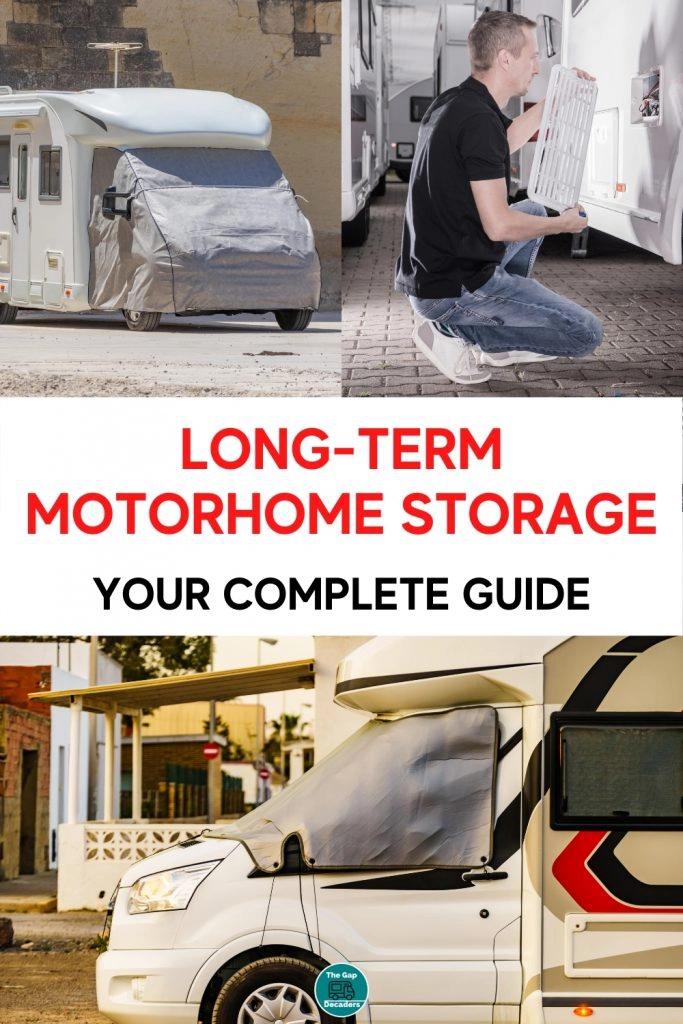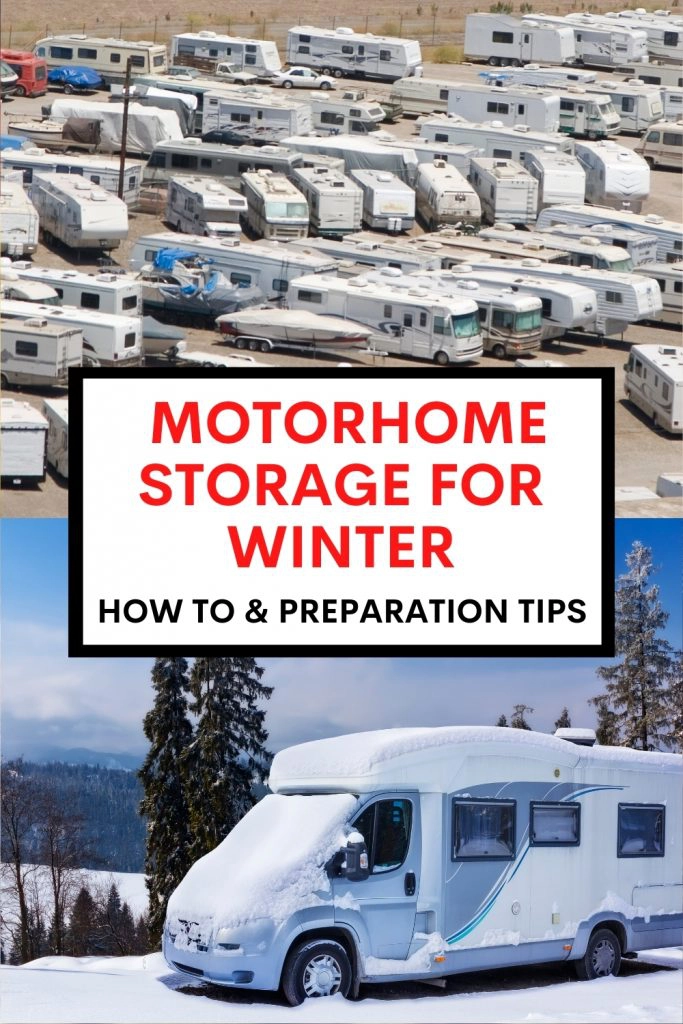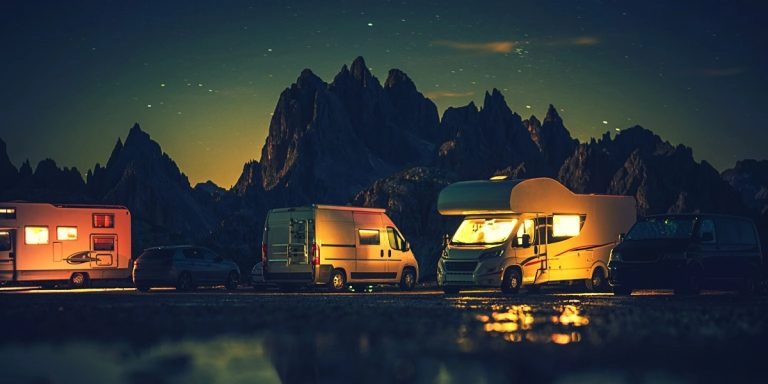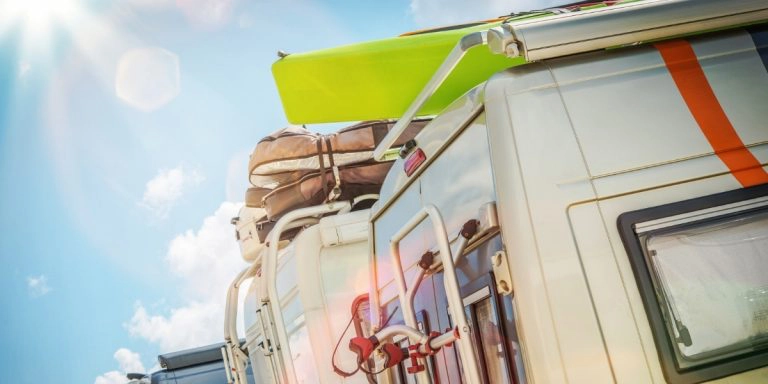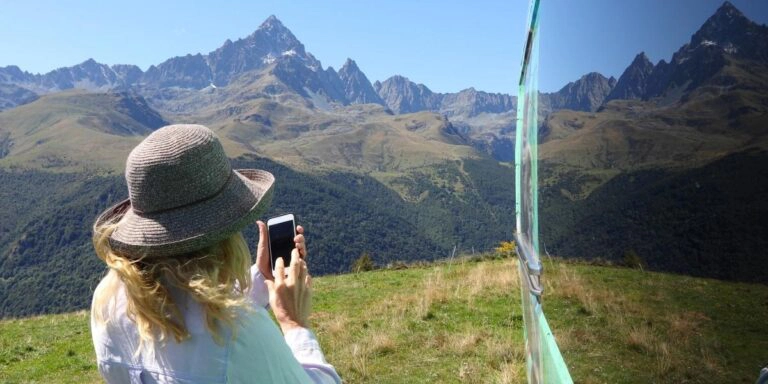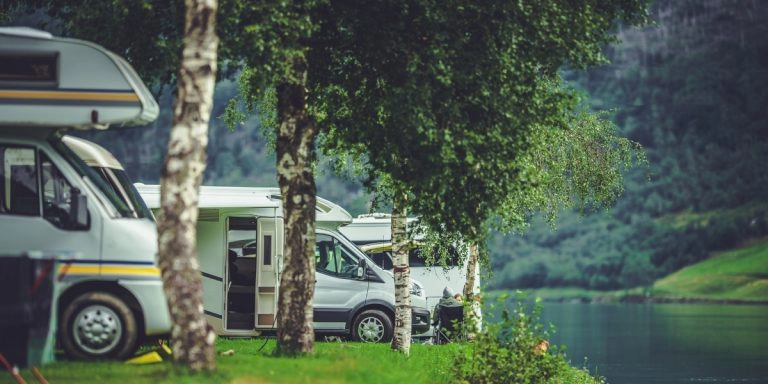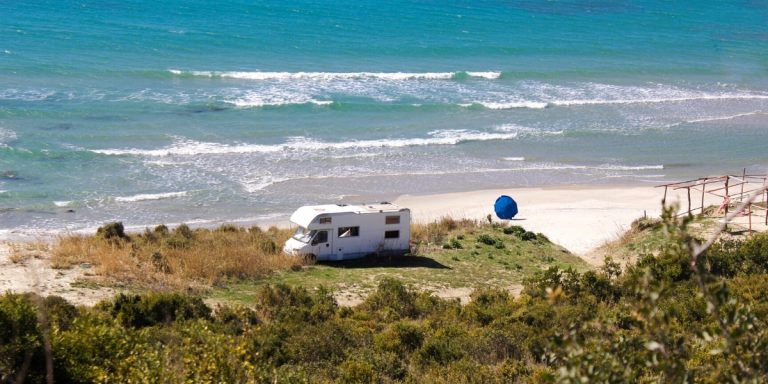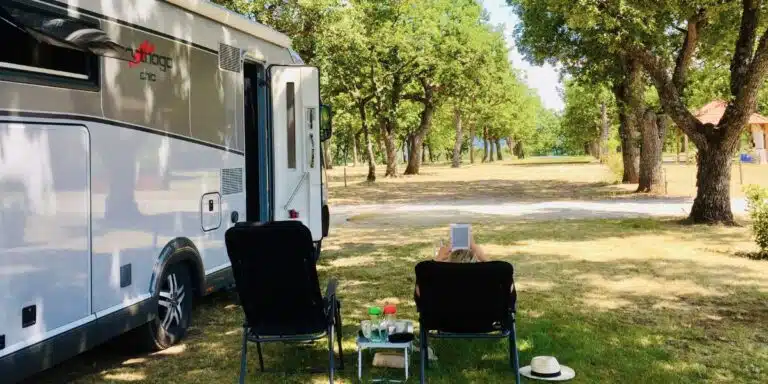This post may contain affiliate links, from which we earn an income. Click here to read our affiliate policy.
Everything You Need to Know About Motorhome Storage
Unless you live in your motorhome permanently, you’ll need to store it (sometimes called laying up) when not in use.
The security of your motorhome whilst its being stored is a primary consideration, as is the preparation process to ensure your motorhome stays in top condition, ready for your next road trip.
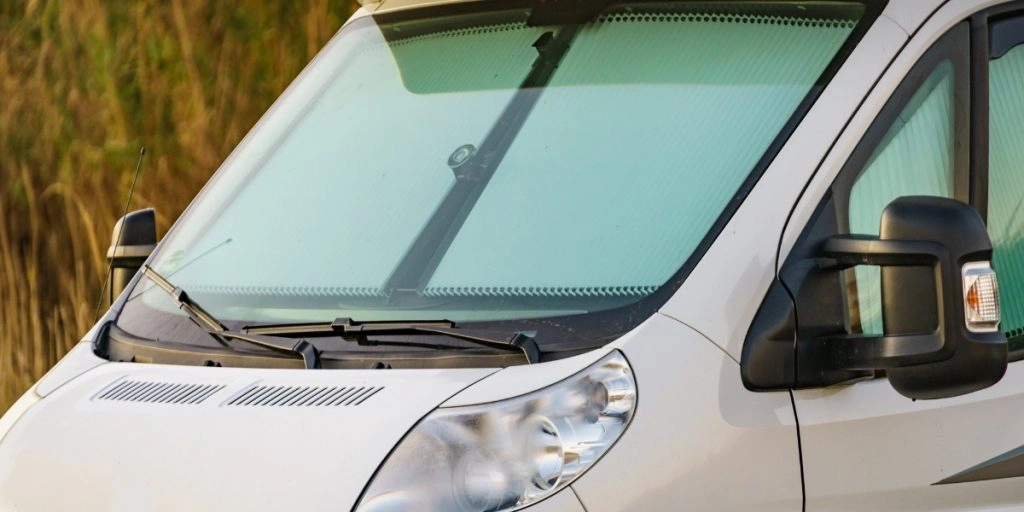
Motorhome Storage Options
Home
According to This is Money, more than 64% of motorhome owners choose to store their pride and joy on their drive, which is a free option and means your van is always close to home and you can check it regularly.
With the majority of motorhome thefts happening from driveways and outside houses, it’s important that you add the right security to your van if you plan to store it in this way.
That means an alarm and tracker ideally, so that if the worst happens there is a chance your motorhome can be recovered. Only 54% of all motorhomes insured in the United Kingdom have an alarm fitted, and only 13% have a tracker fitted. Make sure you’re not one of them, and get this crucial security in place.
A tracker means that your motorhome is always connected via a GPS tracking system which incorporates a range of satellites that are transmitted to GPS devices to give information on location, vehicle speed, time and direction. To have one fitted by a mobile company who will come to your location will cost around £500-600 which usually includes your first year’s subscription.
It’s also worth noting that insurers can be tricky about claims made for motorhome thefts from driveways – if you say it’s on your driveway, then you won’t be covered if you park on the public road outside your home for example.
You might also consider physical security like a locked gate or a security post to deter thieves.
Finally, whenever you go away, you’ll be letting your neighbourhood and any potential thieves know you’re on holiday. Beefing up your home insurance and security in and around your house is a good idea too.
I live in a new housing development, am I allowed to keep my motorhome on my drive?
You should check with the developer if you’re buying a new build property, or your conveyancing solicitor or title deeds if you’re buying a property that has already been lived in. Some houses and developments have restrictive covenants which prohibit the parking of motorhomes or caravans on the drive or within the development.
A well-known scam when you have your van stored on your drive is to receive a knock on the door from someone asking if your motorhome is for sale. This is almost always an attempt to check out your security arrangements and gather information which could help the thief to steal your motorhome. If this happens to you, review your security arrangements and perhaps look at additional deterrents.
Motorhome Storage Site
A great option for many motorhome owners, there are thousands of secure storage sites where you can store your motorhome for a few months to a few years. When choosing a site you should look for the following as a minimum:
Always visit the site first before committing or paying for a space. The yard should be well kept and tidy, and the owner should be happy for you to take a look around.
Make sure the security features advertised are actually in place. If there are motorhome owners there, ask their opinion of the site.
You won’t find motorhome storage facilities with fully serviced pitches, but you may want to look at whether the site has any water or grey and black waste facilities. Can you wash your motorhome there? Is there a motorhome service workshop nearby where you can get repairs done or an annual habitation check?
All these extras make life just a little bit simpler and provide added value to what can be an expensive exercise.
CaSSOA Storage Site
The Caravan Storage Site Owners’ Association represent over 500 leisure vehicle storage site owners’ across the UK and work towards minimising touring caravan and motorhome theft by promoting the highest levels of security.
CaSSOA bronze site’s have all the security features listed above. As you progress through the silver, gold and platinum levels of site, you also get the following:
Camping & Caravan Club Storage
Members of the Camping and Caravanning Club can store their motorhomes at a favourite site or one that’s close to home, but you do have to request access and may not be able to visit over winter if the site is closed. Costs range form £450-850 a year.
Caravan & Motorhome Club Storage
The Caravan Club offers similar storage, with seven of their sites also being CaSSOA registered. Costs start at £365 for a full year of storage.
Motorhome Storage Insurance
You must tell your insurance company when you store your motorhome away from home. If you fail to do this, you risk your insurance bing invalidated should the worst happen.
If you choose one of the CaSSOA sites, you may be able to negotiate your van insurance premiums down when your motorhome is in storage.
Sometimes its possible to reduce your level of cover to what’s called ‘laid-up’ cover. This means that the insurer covers you for fire, theft and damage at the storage yard (which they are likely to want to be CaSSOA registered) but it does prevent you from taking your motorhome out for a run every 4-6 weeks, which would be the ideal scenario to keep things ticking over.
Check with your insurer, some will offer a laid-up policy. We found that Lancaster Insurance (a classic car insurance company) offered a laid-up policy when we needed to store our van for six months, as we were unable to reduce our level of cover with our insurers at the time.
Reputable motorhome storage sites will have public liability insurance and owners liability insurance, which may cover you if there is a fire or flood, but it’s unlikely to cover accidental damage to your motorhome.
CaSSOA offer motorhome and caravan insurance if you store at one of their sites but this is an additional cost.
Useful Motorhoming Resources
Motorhome Storage Overseas
If you travel long-term or full-time in your motorhome, the chances are you’ll want to catch a flight home to the UK at some point, which means leaving your motorhome secure wherever you are.
Check your motorhome insurance policy carefully regarding this, as some insurers state that you may only leave your vehicle unattended for 24 or 48 hours when travelling overseas.
We needed to do this a few years back in Spain and had to submit the details of our proposed camper storage arrangements to the insurance underwriters. We tried submitting secured airport parking and a campsite, but these did not meet their requirements and we had to find a storage site with many of the features you would see at a CaSSOA site.
And then they charged us an additional premium of £85 for two weeks!
Motorhome Storage Costs
What does secure motorhome storage cost? Costs can vary greatly, from nothing if you choose your drive, to more than £75 a month.
How much you pay depends on your location in the country, whether the site is covered, the security features offered and the size of your motorhome.
Preparing Your Motorhome for Summer or Winter Lay Up
If your motorhome is going into storage for more than a few weeks, you’ll need to take steps to ensure your van stays in tip top condition for your next trip. We don’t offer specific winter storage tips as generally, the same steps should be taken regardless of the time of year.
Power
Leisure Batteries
It seems that every motorhome owner has their own ideas about how to manage power and leisure batteries when their van is in storage.
Depending on the age and condition of your motorhome, you may be able to leave it permanently plugged in, if EHU is available at your storage site. But this can pose a risk if something goes wrong, so we would advise checking regularly.
If you don’t want to, or can’t, leave your van hooked up, then a few hours of electricity every month will be enough to keep the leisure battery healthy, either via EHU or a run out. You should turn off your control panel and all electrical functions and isolate your leisure batteries if you decide to take this option.
If your motorhome is stored outside and you have solar power, then we would suggest leaving this on to provide a trickle feed. Leave your solar regulator on and turn off your control panel.
Some people use a smart charger like this one to ensure the leisure batteries are kept at the correct levels.
Before you decide what to do about power during storage, check your motorhome manual where the manufacturer will give instructions on what steps you can safely take.
Engine Battery
Your alarm and tracker run from the engine 12v battery so should continue to work as normal if you disconnect your power supply. You may find that your engine battery is flat after an extended storage period, especially if you’re storing your motorhome over winter, when temperatures can affect the batteries.
If you have a split charge relay and have opted to leave solar power on, or hook up for a few hours every month, then this will keep both sets of batteries charged.
If this is not the case, you will need to run the engine every 4-6 weeks, ideally by going out for a drive, or use a smart charger if visiting your motorhome is not an option.
Make sure to take a set of jump start leads or a battery charger with you when you visit your motorhome in storage.
Water
When cold weather approaches and your motorhome is in storage, it’s important that your motorhome’s plumbing system is drained of all its water. When water freezes it expands, which can lead to burst pipes and damaged fittings, just like at home.
When draining down you must make sure that you drain as much water from the system as possible. Firstly, locate all the draining points, which are usually found serving the fresh water tank and the water heater – your motorhome users manual should also give you this information.
You should take the following steps to ensure you drain down effectively:
Heating
If you have a wet heating system, your manufacturer will have specific instructions about draining the system for winter storage, or leaving the heating on a frost setting over winter to protect pipes and keep your motorhome dry.
Usually, you do not have to drain the water from the radiators or pipes, just the fresh water from the water boiler. This is because most motorhome wet heating system pipes and radiators are filled with anti-freeze instead of water and are not at risk of freezing.
Even if your motorhome is winterised or has a double floor, it’s good practice to drain down your fresh and waste water. This is because a winterized motorhome is thermally efficient but relies on the heat generated by people and the heating systems being in use, to make it so.
Is my motorhome winterized?
The definition of a winterised motorhome is as varied as the number of motorhome manufacturers! The best winterised motorhomes have all the pipes and water tanks inside the van, usually within a double insulated floor.
Some winter proof motorhomes use electrical heating elements, lagging and ‘silver bubbles’ to wrap and coat their vulnerable parts and use thermal insulation within walls, ceiling and floor.
Many manufacturers offer ‘winter packs’ which add some or all of these elements to the van, which make life comfortable if you live in your motorhome during winter. It is also possible to retro-fit heated blankets and lagging for tanks and pipes.
Gas
Gas should be isolated in the van, where you’ll find switches for your hob, oven, boiler and possibly your external BBQ point, if you have one.
You should also isolate at the gas bottle(s) in your gas locker. Some storage yards may ask you to remove your gas cylinders completely.
Preparing the Exterior
Wash your motorhome using a good motorhome bodywork cleaner, and treat rubber seals with a product like this as you go. You can also wax your motorhome – along with treating your seals this helps to prevent black streaks forming.
Spray all exterior hinges with silicone oil to stop them from seizing. Don’t forget the hingers of the corner steadies, if you have them.
If you are not covering your motorhome, you can use a product like Wet & Forget on the roof, which should stop algae forming during storage and an overwintering fluid like Fenwicks Wintering Protector.
To Cover or Not To Cover?
Lots of people like to cover their motorhome if it’s stored outside during the winter months. Make sure to use a breathable cover like this one, rather than a tarpaulin or polythene sheet which will cause condensation inside.
Make sure the cover is fitted correctly and cannot be blown about or or become partially loose – it’s surprising how much damage a cover can cause if not properly secured.
Preparing the Interior
Give the whole inside a thorough clean, using disinfectant in the bathroom and kitchen areas.
Clean the fridge (and freezer if you have one) and prop the fridge door open open. Fit the external fridge vents, or if you have a fridge with an inner vent (usually found in the space underneath the fridge behind a panel) close it.
Take out your toilet cassette and clean, leaving the valve open when you put the cassette back into place.
Remove all your bed linen, towels, duvets and pillows to store at home if you have room. If not, use vacuum storage bags like these to keep your linen airtight and safe from nesting mice.
Prop up mattresses and sofa cushions to allow air to circulate around them – this helps to prevent condensation and mould.
If you have an over-cab or drop down bed, lower it by 10cm or so to allow air to circulate.
Remove batteries from any smoke and C02 alarms.
Remove all documents and contents for the safe to store at home.
Mice in my Motorhome!
Mice can do a lot of damage to your electrical cables and wiring if they get into your motorhome.
To prevent rodents getting into your motorhome, follow these tips:
You’ll know if you have a mouse when you visit your van – there will be telltale signs like droppings and furnishings fraying in odd places.
There are lots of humane and in-humane ways to catch mice in a motorhome, which usually involve setting mouse traps – you can find out more here.
Parking Your Motorhome
If your motorhome is going to be laid up for a longish period and you are not intending to drive it every 4-6 weeks, then jacking it up onto axle stands is a good idea. It takes the weight off the wheels and tyres. Doing this also makes your motorhome more difficult to steal.
Make sure your axle stands are suitable for the weight of your vehicle and research online how to use them correctly for your motorhome make and model. These high quality and sturdy Fiamma axle stands would do a good job.
If you decide to use axle stands you should always chock the wheels too.
The alternative to this is to use wheel savers or cradles which prevent ovalization of your wheels.
Leave the engine in gear and your handbrake off, to prevent seizing.
Set the alarm and any physical security devices, and you’re ready to go home!
Are you looking for more motorhome tips & advice? Check out these top posts…
An Easy Guide to Motorhome Electrics
An Easy Guide to Motorhome Weight: All You Need to Know
An Easy Guide to Motorhome WiFi & Internet (2025 Update)
Motorhomers Choice – Top 10 Motorhome Campsites UK
Motorhome Wild Camping – Your Complete Guide
Touring Europe in a Motorhome: The Best & Only Guide You Need!
Love it? Pin it!
